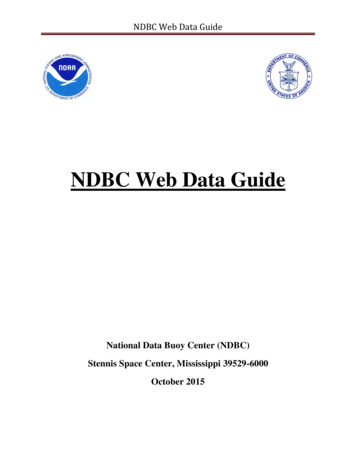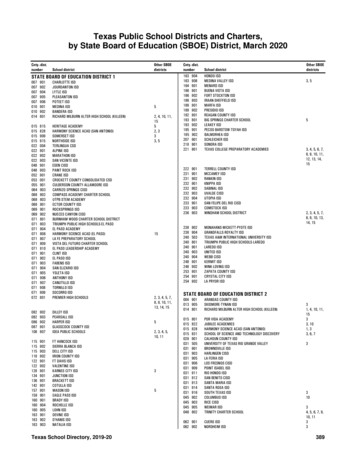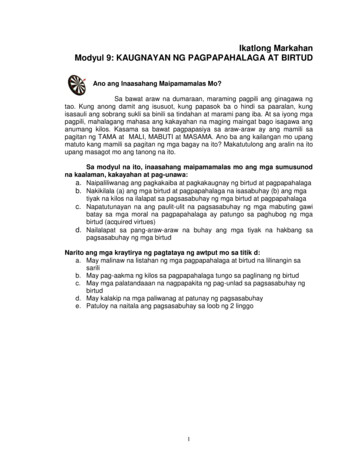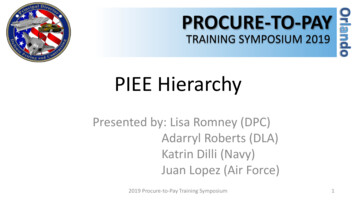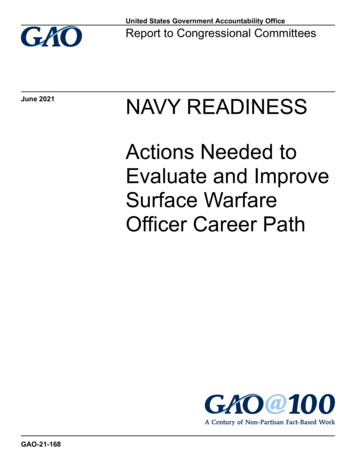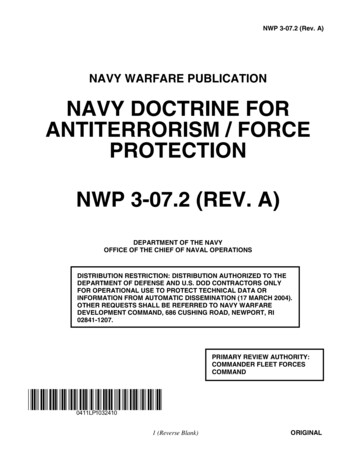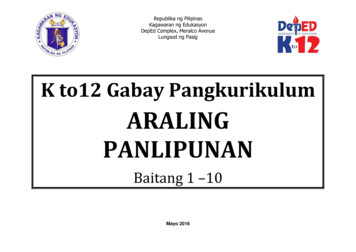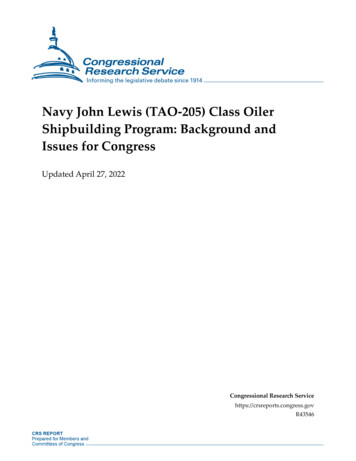
Transcription
Navy John Lewis (TAO-205) Class OilerShipbuilding Program: Background andIssues for CongressUpdated April 27, 2022Congressional Research Servicehttps://crsreports.congress.govR43546
Navy John Lewis (TAO-205) Class Oiler Shipbuilding ProgramSummaryThe Navy procured its first John Lewis (TAO-205) class oiler in FY2016, and a total of eighthave been procured through FY2022, including the seventh and eighth in FY2022. The first sixwere procured under a block buy contract authorized by Section 127 of the FY2016 NationalDefense Authorization Act (S. 1356/P.L. 114-92 of November 25, 2015). TAO-205s are beingbuilt by General Dynamics/National Steel and Shipbuilding Company (GD/NASSCO) of SanDiego, CA.Current Navy plans call for procuring a total of 20 TAO-205s. The Navy’s proposed FY2023budget requests 794.7 million for the procurement of the ninth TAO-205 class ship, and anadditional 128.1 million in cost-to-complete procurement funding to cover cost growth on TAO205s procured in prior years.Issues for Congress include the following: cost growth and schedule delays in the TAO-205 program;whether to procure in FY2023 one TAO-205 class ship (as requested), no TAO205 class ship, or two TAO-205 class ships;whether to procure TAO-205s in FY2023 and subsequent years under a multiyearprocurement (MYP) or block buy contract;the total number of TAO-205s the Navy will require in coming years to supportits operations, particularly in light of the Navy’s new Distributed MaritimeOperations (DMO) operating concept;issues regarding the TAO-205 program discussed in a June 2021 GovernmentAccountability Office (GAO) report assessing major DOD acquisition programs;andwhether to encourage or direct the Navy to build TAO-205s with more ship selfdefense equipment than currently planned by the Navy.Congressional Research Service
Navy John Lewis (TAO-205) Class Oiler Shipbuilding ProgramContentsIntroduction . 1Background . 1Navy Fleet Oilers . 1Role of Fleet Oilers . 1Existing Kaiser (TAO-187) Class Oilers . 2TAO-205 Program . 4Program Name . 4Ship Design and Capabilities . 5Planned Total Procurement Quantity . 5Annual Procurement Quantities . 6Unit Procurement Cost . 6Builder . 6Block Buy Contract. 6FY2021 and FY2022 Legislation Regarding U.S. Content Requirement forCertain Components . 7FY2023 Funding . 9Issues for Congress . 9Cost Growth and Schedule Delays . 9Number of TAO-205s to Procure in FY2023 . 10Multiyear Procurement (MYP) or Block Buy Contracting . 10Total Required Number of TAO-205s . 11Issues Discussed in June 2021 GAO Report . 11TAO-205 Ship Self-Defense Equipment . 13Legislative Activity for FY2023 . 13Summary of Congressional Action on FY2023 Funding . 13FiguresFigure 1. Fleet Oiler Conducting an UNREP . 2Figure 2. Fleet Oiler Conducting an UNREP . 3Figure 3. Fleet Oiler Conducting an UNREP . 3Figure 4. Kaiser (TAO-187) Class Fleet Oiler . 4Figure 5. John Lewis (TAO-205) . 5TablesTable 1. Congressional Action on FY2023 Funding for Additional TAO-205s . 13AppendixesAppendix A. TAO-205 Ship Self-Defense Equipment . 14Congressional Research Service
Navy John Lewis (TAO-205) Class Oiler Shipbuilding ProgramContactsAuthor Information. 15Congressional Research Service
Navy John Lewis (TAO-205) Class Oiler Shipbuilding ProgramIntroductionThis report provides background information and issues for Congress on the John Lewis (TAO205) class oiler shipbuilding program, a program to build a new class of 20 fleet oilers for theNavy. The issue for Congress is whether to approve, reject, or modify the Navy’s annual shipauthorization and funding requests and acquisition strategy for the program. Congress’s decisionson this issue could affect Navy capabilities and funding requirements and the U.S. shipbuildingindustrial base.BackgroundNavy Fleet OilersRole of Fleet OilersThe primary role of Navy fleet oilers is to transfer fuel to Navy surface ships that are operating atsea, so as to extend the operating endurance of these surface ships and their embarked aircraft.Fleet oilers also provide other surface ships with lubricants, fresh water, and small amounts of drycargo. Fleet oilers transfer fuel and other supplies to other surface ships in operations calledunderway replenishments (UNREPs). During an UNREP, an oiler steams next to the receivingship and transfers fuel by hose (see Figure 1, Figure 2, and Figure 3).1Oilers are one kind of Navy UNREP ship; other Navy UNREP ships include ammunition ships,dry cargo ships, and multiproduct replenishment ships. The Navy’s UNREP ships are knownmore formally as the Navy’s combat logistics force (CLF). Most of the Navy’s CLF ships areoperated by the Military Sealift Command (MSC).Although the role of fleet oilers might not be considered as glamorous as that of other Navy ships,fleet oilers are critical to the Navy’s ability to operate in forward-deployed areas around the worldon a sustained basis. The U.S. Navy’s ability to perform UNREP operations in a safe and efficientmanner on a routine basis is a skill that many other navies lack. An absence of fleet oilers wouldsignificantly complicate the Navy’s ability to operate at sea on a sustained basis in areas such asthe Western Pacific or the Indian Ocean/Persian Gulf region. The Navy states that1The Navy states thatA typical connected replenishment starts when a warship makes an “approach” on a CLF ship. TheCLF ship maintains steady course and speed while the “customer ship” approaches and comesalongside the CLF ship, matching course and speed. The distance between the two ships is usuallybetween 120-200 feet. The CLF ship then passes heavy metal wires, to the customer ship, that areconnected at the replenishment stations. These wires are placed under tension to support fuel hosesfor refueling operations or trolleys that move pallets of provisions, ammunition, or other cargo fromship to ship. Ships with flight decks can also receive provisions and ammunition via verticalreplenishment. During this evolution a helicopter transfers cargo in external sling loads, or in thecase of mail or passengers, inside the helicopter.(Statement of Mr. F. Scott DiLisio, Director, Strategic Mobility / Combat Logistics Division,Office of the Chief of Naval Operations, on the Logistics and Sealift Force Requirements and ForceStructure Assessment Before the House Armed Services Committee Seapower and ProjectionForces Subcommittee, July 30, 2014, p. 3.)Congressional Research Service1
Navy John Lewis (TAO-205) Class Oiler Shipbuilding Programthe ability to rearm, refuel and re-provision our ships at sea, independent of any restrictionsplaced on it by a foreign country, is critical to the Navy’s ability to project warfightingpower from the sea.As the lifeline of resupply to Navy operating forces underway, the ships of the Navy’sCombat Logistic Force (CLF) enable Carrier Strike Groups and Amphibious Ready Groupsto operate forward and remain on station during peacetime and war, with minimal relianceon host nation support.2Figure 1. Fleet Oiler Conducting an UNREPSource: Navy photo accessed May 5, 2014, at http://www.navy.mil/view image.asp?id 163895. The Navy statesthat the photo is dated October 24, 2013, and shows the oiler Tippecanoe (TAO-199) extending its fuel probe tothe Aegis cruiser USS Antietam (CG-54), a part of the George Washington (CVN-73) Carrier Strike Group, in theSouth China Sea.Existing Kaiser (TAO-187) Class OilersThe Navy’s existing force of fleet oilers consists of 15 Henry J. Kaiser (TAO-187) class ships(Figure 4), commonly called Kaiser-class oilers for short.3 These ships were procured betweenFY1982 and FY1989 and entered service between 1986 and 1996. They have an expected servicelife of 35 years; the first ship in the class reached that age in 2021. The ships are about 677 feetlong and have a full load displacement of about 41,000 tons, including about 26,500 tons of fueland other cargo. The ships were built by Avondale Shipyards of New Orleans, LA, a shipyard thateventually became part of the shipbuilding firm Huntington Ingalls Industries (HII). HII2Statement of Mr. F. Scott DiLisio, Director, Strategic Mobility / Combat Logistics Division, Office of the Chief ofNaval Operations, on the Logistics and Sealift Force Requirements and Force Structure Assessment Before the HouseArmed Services Committee Seapower and Projection Forces Subcommittee, July 30, 2014, pp. 2-3.3 The oilers shown in Figure 1, Figure 2, and Figure 3 are also Kaiser-class class oilers.Congressional Research Service2
Navy John Lewis (TAO-205) Class Oiler Shipbuilding Programsubsequently wound down Navy shipbuilding operations at Avondale, and the facility no longerbuilds ships. (HII continues to operate two other shipyards that build Navy ships.)Figure 2. Fleet Oiler Conducting an UNREPSource: Cropped version of Navy photo accessed May 5, 2014, at http://www.navy.mil/view image.asp?id 61415. The Navy states that the photo is dated July 13, 2008, and shows the oiler Leroy Grumman (TAO-195)refueling the frigate Underwood (FFG-36) during an exercise with the Iwo Jima (LHD-7) Expeditionary StrikeGroup in the Atlantic Ocean.Figure 3. Fleet Oiler Conducting an UNREPSource: Cropped version of Navy photo accessed May 5, 2014, at http://www.navy.mil/view image.asp?id 1737.The Navy states that the photo is dated June 19, 2002, and shows the oiler Walter S. Diehl (TAO-193), at center,conducting simultaneous UNREPs with the aircraft carrier John F. Kennedy (CV-67) and the Aegis destroyerHopper (DDG-70). CV-67, a conventionally powered carrier, has since retired from the Navy, and all of theNavy’s aircraft carriers today are nuclear powered. Even so, Navy oilers continue to conduct UNREPs with Navyaircraft carriers to provide fuel for the carriers’ embarked air wings.Congressional Research Service3
Navy John Lewis (TAO-205) Class Oiler Shipbuilding ProgramFigure 4. Kaiser (TAO-187) Class Fleet OilerSource: Cropped version of U.S. Navy image accessed April 14, 2014, at 03-N-TG831-240.jpg. (The oilers shown in Figure 1, Figure 2, and Figure 3 are alsoKaiser-class class oilers.)TAO-205 ProgramProgram NameNavy oilers carry the designation TAO (also typed as T-AO). The T means the ship is operated byMSC with a mostly civilian crew; the A means it is an auxiliary ship of some kind; and the Omeans that it is, specifically, an oiler. TAO-205 will be the Navy’s next oiler after TAO-204,which is the final Kaiser-class oiler.On January 6, 2016, then-Secretary of the Navy Ray Mabus announced that the TAO-205 classships will be named for “people who fought for civil rights and human rights,”4 and that the firstship in the class, TAO-205, which was procured in FY2016, was being be named forRepresentative John Lewis,5 making TAO-205 one of a small number of Navy ships that havebeen named for people who were living at the time that the naming announcement was made.6TAO-205 class ships consequently are now known as John Lewis-class oilers.Valerie Insinna, “Navy to Name Next Generation Oilers for Civil Rights Icons,” Defense Daily, January 7, 2016. Formore on the names of TAO-205 class ships, see CRS Report RS22478, Navy Ship Names: Background for Congress,by Ronald O'Rourke.5 “Secretary of the Navy Ray Mabus Names Fleet Replenishment Oiler,” Navy News Service, January 6, 2016; SamLaGrone, “SECNAV Mabus Names First TAO(X) Next Generation Oiler After Rep. John Lewis,” USNI News, January6, 2016; “Navy to Name New Oiler after Civil Rights Icon,” Military.com, January 6, 2020; Valerie Insinna, “Navy toName Next Generation Oilers for Civil Rights Icons,” Defense Daily, January 7, 2016.6 Representative Lewis died on July 17, 2020. For more on Navy ships named for people who were living at the timethat the naming announcement was made, see CRS Report RS22478, Navy Ship Names: Background for Congress, byRonald O'Rourke.4Congressional Research Service4
Navy John Lewis (TAO-205) Class Oiler Shipbuilding ProgramShip Design and CapabilitiesThe TAO-205 class design (Figure 5) will have capabilities similar to those of the Kaiser-classships, and will rely on existing technologies rather than new technologies. To guard against oilspills, TAO-205s are to be double-hulled, like modern commercial oil tankers, with a spacebetween the two hulls to protect the inner hull against events that puncture the outer hull. (Thefinal Kaiser-class ships are double-hulled, but earlier ships in the class are single-hulled.)Figure 5. John Lewis (TAO-205)Source: Cropped version of photograph accompanying National Steel and Shipbuilding Company, “GeneralDynamics NASSCO Launches First Ship in the T-AO Fleet Oiler Program for the U.S. Navy,” January 13, 2021.Note: Launching is when a ship that is under construction is put into the water for the final phases of itsconstruction.Planned Total Procurement QuantityCurrently Planned Total Procurement Quantity of 20The required number of oilers largely depends on the numbers and types of other surface ships(and their embarked aircraft) to be refueled, and the projected operational patterns for these shipsand aircraft. The Navy’s current force-level objective, released on December 15, 2016, calls forachieving and maintaining a 355-ship fleet, including 32 CLF ships, of which 20 are to be TAO205s.7 Consistent with this plan, the Navy currently wants to procure a total of 20 TAO-205s.For more on the Navy’s 355-ship force-level goal, see CRS Report RL32665, Navy Force Structure and ShipbuildingPlans: Background and Issues for Congress, by Ronald O'Rourke.7Congressional Research Service5
Navy John Lewis (TAO-205) Class Oiler Shipbuilding ProgramPotential Change in Planned Total Procurement QuantityThe Navy and DOD have been working since 2019 to develop a new Navy force-level goal toreplace the Navy’s current 355-ship force-level goal that might or might not change the currentlyplanned total procurement quantity of 20 TAO-205s. The future mix of CLF ships is to include anew class of ship, called the Next-Generation Logistics Ship (NGLS), that is to be smaller andindividually less expensive than the TAO-205 design.8 For additional discussion of Navy andDOD efforts to develop a new Navy force-level goal to replacement the current 355-ship goal, seethe CRS overview report on Navy force structure and shipbuilding plans.9Annual Procurement QuantitiesThe Navy procured the first TAO-205 in FY2016, and a total of eight have been procured throughFY2022, including the seventh and eighth in FY2022. The Navy’s five-year (FY2023-FY2027)shipbuilding plan programs the procurement of six more TAO-205s in FY2023-FY2027, inannual quantities of 1-2-1-1-1.Unit Procurement CostUnder the Navy’s FY2023 budget submission, the TAO-205s to be procured in the five-yearperiod FY2023-FY2027 have estimated unit procurement costs of 794.7 million, 678.9 million(an average for the two ships programmed for procurement that year), 732.8 million, 746.8million, and 764.0 million, respectively.BuilderTAO-205s are being built by General Dynamics/National Steel and Shipbuilding Company(GD/NASSCO) of San Diego, CA, a shipyard that builds Navy auxiliaries, DOD sealift ships,and commercial cargo ships.Block Buy ContractThe first six TAO-205s were procured under a block buy contract that was authorized by Section127 of the FY2016 National Defense Authorization Act (S. 1356/P.L. 114-92 of November 25,2015). It was earlier estimated that the block buy contract would reduce the procurement cost ofthe second through sixth TAO-205s by an average of about 45 million each, compared to costsunder the standard or default DOD approach of annual contracting.10 The Navy states that about8For more on the NGLS program, see CRS In Focus IF11674, Navy Next-Generation Logistics Ship (NGLS) Program:Background and Issues for Congress, by Ronald O'Rourke.9 CRS Report RL32665, Navy Force Structure and Shipbuilding Plans: Background and Issues for Congress, byRonald O'Rourke10 The Senate Armed Services Committee, in its report (S.Rept. 114-49 of May 19, 2015) on the FY2016 NationalDefense Authorization Act (S. 1376), statedFleet replenishment oiler program (sec. 118)The committee recommends a provision [Section 118] that would grant the Secretary of the Navycontracting authority to procure up to six fleet replenishment oilers (T–AO(X)). This new ship classis a nondevelopmental recapitalization program based on existing commercial technology andstandards. The ship design is considered to be low risk by the Navy, with the design scheduled tobe complete prior to the start of construction on the lead ship. This provision would generate anestimated 45.0 million in savings per ship compared to annual procurement cost estimates. Inaddition, the provision would provide a long-term commitment to the shipbuilder and vendors,Congressional Research Service6
Navy John Lewis (TAO-205) Class Oiler Shipbuilding Program 35 million of the 45 million in per-ship savings will come from using advance procurement(AP) funding for batch-ordering TAO-205 components. The Navy states that this use of APfunding could have occurred under annual contracting, and that the savings that are intrinsic tothe block buy contract are thus about 10 million per ship.11FY2021 and FY2022 Legislation Regarding U.S. Content Requirement forCertain ComponentsSection 845 of the FY2021 National Defense Authorization Act (H.R. 6395/P.L. 116-283 ofJanuary 1, 2021) states (emphasis added)SEC. 845. MISCELLANEOUS LIMITATIONS ON THE PROCUREMENT OF GOODSOTHER THAN UNITED STATES GOODS.(a) IN GENERAL.—Section 2534 of title 10, United States Code, is amended—(1) in subsection (a)—(A) by striking paragraphs (2) through (5) and redesignating paragraph (6) as paragraph(3);(B) by inserting after paragraph (1) the following new paragraph:‘‘(2) COMPONENTS FOR NAVAL VESSELS.—The following components of vessels,to the extent they are unique to marine applications:‘‘(A) Gyrocompasses.‘‘(B) Electronic navigation chart systems.‘‘(C) Steering controls.‘‘(D) Propulsion and machinery control systems.‘‘(E) Totally enclosed lifeboats.’’;(C) in paragraph (3), as so redesignated, by striking ‘‘subsection (k)’’ and inserting‘‘subsection (j)’’; and(D) by adding at the end the following new paragraph:which would enable workforce stability and planning efficiency. (Pages 11-12)The committee print that includes the legislative text and joint explanatory statement for the enacted FY2016 NationalDefense Authorization Act (S. 1356/P.L. 114-92 of November 25, 2015) statedFleet replenishment oiler program (sec. 127)The Senate amendment contained a provision (sec. 118) that would grant the Secretary of the Navycontracting authority to procure up to six fleet replenishment oilers (T–AO (X)). This new shipclass is a non-developmental recapitalization program based on existing commercial technologyand standards. The ship design is considered to be low risk by the Navy, with the design scheduledto be complete prior to the start of construction on the lead ship. This provision would enable anestimated 45.0 million in savings per ship, for ships 2–6, for a total of 225.0 million in savingscompared to current annual procurement cost estimates.(114th Congress, 1st Session, Committee Print No. 2, National Defense Authorization Act for FiscalYear 2016, Legislative Text and Joint Explanatory Statement to accompany S. 1356, P.L. 114-92,November 2015, Printed for the use of the Committee on Armed Services of the House ofRepresentatives, p. 608)For more on block buy contracts, see CRS Report R41909, Multiyear Procurement (MYP) and Block Buy Contractingin Defense Acquisition: Background and Issues for Congress, by Ronald O'Rourke and Moshe Schwartz.11 Source: Navy briefing on TAO-205 program for CRS and CBO, April 12, 2019.Congressional Research Service7
Navy John Lewis (TAO-205) Class Oiler Shipbuilding Program‘‘(4) COMPONENTS FOR T–AO 205 CLASS VESSELS.—The followingcomponents of T–AO 205 class vessels:‘‘(A) Auxiliary equipment, including pumps, for all shipboard services.‘‘(B) Propulsion system components, including engines, reduction gears, andpropellers.‘‘(C) Shipboard cranes.‘‘(D) Spreaders for shipboard cranes.’’;(2) by amending subsection (b) to read as follows:‘‘(b) MANUFACTURER IN THE NATIONAL TECHNOLOGY AND INDUSTRIALBASE.—A manufacturer meets the requirements of this subsection if the manufacturer ispart of the national technology and industrial base.’’;(3) in subsection (c)—(A) by striking ‘‘ITEMS.—’’ and all that follows through ‘‘Subsection (a) does not apply’’and inserting ‘‘ITEMS.—Subsection (a) does not apply’’; and(B) by striking paragraphs (2) though (5);(4) in subsection (g)—(A) by striking ‘‘(1) This section’’ and inserting ‘‘This section’’; and(B) by striking paragraph (2);(5) in subsection (h), by striking ‘‘subsection (a)(3)(B)’’ and inserting ‘‘subsection (a)(2)’’;(6) in subsection (i)(3), by striking ‘‘Under Secretary of Defense for Acquisition,Technology, and Logistics’’ and inserting ‘‘Under Secretary of Defense for Acquisitionand Sustainment’’;(7) by striking subsection (j);(8) by redesignating the first subsection designated subsection (k) (relating to ‘‘Limitationon Certain Procurements Application Process’’) as subsection (j); and(9) in subsection (k) (relating to ‘‘Implementation of Auxiliary Ship ComponentLimitation’’), by striking ‘‘Subsection (a)(6)’’ and inserting ‘‘Subsection (a)(3)’’.(b) REVIEW OF SELECT COMPONENTS.—The Secretary of the Defense shall expeditethe review period under paragraph (3)(B) of section 2534(j) of title 10, United States Code,as redesignated by subsection (a), to not more than 60 days for applications submittedpursuant to such section 2534(j) for the following components for auxiliary ships:(1) Auxiliary equipment, including pumps, for all shipboard services.(2) Propulsion system components, including engines, reduction gears, and propellers.(3) Shipboard cranes.(4) Spreaders for shipboard cranes.Section 8103(a) of the FY2022 DOD Appropriations Act (Division C of H.R. 2471/P.L. 117-103of March 15, 2022) states:SEC. 8103. (a) None of the funds provided in this Act for the TAO Fleet Oiler programshall be used to award a new contract that provides for the acquisition of the followingcomponents unless those components are manufactured in the United States: Auxiliaryequipment (including pumps) for shipboard services; propulsion equipment (includingCongressional Research Service8
Navy John Lewis (TAO-205) Class Oiler Shipbuilding Programengines, reduction gears, and propellers); shipboard cranes; spreaders for shipboard cranes;and anchor chains specifically for the seventh and subsequent ships of the fleet.FY2023 FundingThe Navy’s proposed FY2023 budget requests 794.7 million for the procurement of the ninthTAO-205 class ship and an additional 128.1 million in cost-to-complete procurement funding tocover cost growth on TAO-205s procured in prior years.Issues for CongressCost Growth and Schedule DelaysOne issue for Congress concerns cost growth and schedule delays in the TAO-205 program. TheNavy informed CRS on August 31, 2021, that the estimated procurement cost of the lead ship inthe TAO-205 program had increased to 759.4 million12—an increase of 85.2 million, or 12.6%,from the ship’s originally estimated and funded procurement cost of 674.2 million. The deliverydate for the ship has also been delayed. One cause of the cost growth and delivery delay is anincident in July 2018 that flooded a graving dock (i.e., dry dock) at the TAO-205 shipbuilder,GD/NASSCO.13 Other causes of cost growth include cyber security change orders that were notprovided in the original shipbuilding construction contract award, and cost growth ingovernment-furnished equipment (GFE) for the ship.14 The delivery dates for subsequent ships inthe program have also been delayed.As noted earlier, cost growth in the TAO-205 program has required the Navy to request cost-tocomplete funding to cover cost growth on TAO-205s procured in prior years. The TAO-205program has received a total of 145.7 million in cost-to-complete funding through FY2022. TheNavy’s proposed FY2023 budget, as noted earlier, requests an additional 128.1 million in costto-complete funding, and the Navy’s FY2023 budget submission projects that an additional 113.1 million and 12.6 million will be requested for FY2024 and FY2025, respectively. Thesum of all these figures is 399.549 million, which equates to roughly half the currently estimatedprocurement cost of a TAO-205.As noted later in this report, a June 2021 Government Accountability Office (GAO) report statedthatA 2018 incident involving a flooded dry dock delayed and disrupted the shipbuilder’soperations. With fewer ships under construction at one time, the shipyard must nowallocate the same fixed overhead costs over fewer ships.12Navy information paper on TAO-205 dated August 25, 2021, provided to CRS by Navy Office of Legislative Affairson August 31, 2021.13 For press reports about the graving dock incident and its impacts on work being done at GD/NASSCO, see, forexample, Megan Eckstein, “NASSCO Drydock Floods, Damaging Under-Construction Expeditionary Sea Base,” USNINews, July 13, 2018; David Larter, “Partial Dry-Dock Collapse Floods US Navy Ship Under Construction,” DefenseNews, July 13, 2018; Tyler Rogoway, “Dry Dock Collapse In San Diego Floods Expeditionary Sea Base UnderConstruction,” The Drive, July 13, 2018; Maritime Executive, “Graving Dock Failure at NASSCO Leads to Layoffs,”Maritime Executive, August 14, 2018; Ben Werner, “Navy: Dry Dock Accident Will Set Back Miguel KeithConstruction At Least 6 Months,” USNI News, October 18, 2018.14 Source: Navy FY2022 program briefing on TAO-205 program for CRS and Congressional Budget Office (CBO),July 19, 2021.Congressional Research Service9
Navy John Lewis (TAO-205) Class Oiler Shipbuilding ProgramThe program’s schedule continues to experience delays due to the events of the last twoyears. As we reported last year, as a result of events that began with the 2018 flooding ofone of the shipbuilder’s dry docks, planned delivery of ships two through six slipped by 5to 12 months. The incident did not affect the lead ship’s schedule, but the late delivery ofthe ship’s main engines and certain other components delayed the lead ship’s delivery dateby 7 months. 15The Navy stated in July 2021 that the delivery date for TAO-205 has been delayed from June2021 to March 2022 due to the graving dock incident, late delivery of outfitting materials, and aneed to repair or carry out rework on other parts of the ship, and that the delivery dates of thesecond through sixth ships in the class have been delayed by 12 to 15 months due to the gravingdock incident, late delivery of materials, throughput delays caused by delays in building the firstship, and impacts from the COVID-19 situation.16Number of TAO-205s to Procure in FY2023Another issue for
Apr 27, 2022

